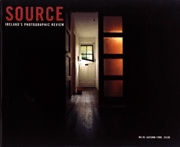Dystopian Chic
The Glenn Dimplex Artists Awards Exhibition was at the Irish Museum of Modern Art 28th May - 19th August 1999
Review by Gavin Murphy
Issue 20 Autumn 1999
View Contents ▸
This year's selection of artists for the Glen Dimplex Award reaffirms the prominence of lens based media in contemporary fine art practice. It also clarifies two divergent strands of such practice: a preoccupation with the craft of photography and the role lens based media can perform in relation to wider structures of knowledge.
The work of Catherine Yass and Hiroshi Sugimoto characterise the first approach. Yass' manipulated imagery of capsule hotels in Tokyo and public toilets reveals a fascination with the possibilities of fresh photographic technologies. The Capsule series consists of four cibachrome transparencies mounted on light boxes. Their repetition highlights a functional, impersonal space with the sterile efficiency of a morgue. This is aided by an eerie vividness achieved by overlaying positive and negative transparencies. Technique conspires with imagery to produce dystopian chic. Such an aesthetic is echoed in the Toilet series. Images of public toilets are rendered through an ultraviolet and pale green sheen to produce a viral hum. The result, however, is work more concerned with mere effect than with scrutinising the role of new technologies and public space. Catherine Yass, Capsule (506), 1999 - Courtesy Asprey Jacques, London
Catherine Yass, Capsule (506), 1999 - Courtesy Asprey Jacques, London
Sugimoto's photographic seascapes and images of key architectural works of the modern era are likewise attuned to the mechanics of, and qualities afforded by, the equipment selected. Tyrrhenian Sea, Mount Polo (1993), for example, consists of three seascapes registering delicate tonal shifts above and below the horizon. The photograph as documentary record (this is the world as it is) dissolves as a penetrating gaze works up the materiality of the surface. This is a tonal essay crafted into being. Likewise, in the second set of images on show, the physicality of architectural structures is voided through metier. The work excels by drawing the viewer so consciously towards the material language of photography on paper. Hiroshi Sugimoto, Casa Batlo II - Gaudi 1998
Hiroshi Sugimoto, Casa Batlo II - Gaudi 1998
The work of Orla Barry and Susan MacWilliam by contrast use photographic media for more direct social commentary. Barry's work is characterised by the sheer amount of material in the gallery space: there was a video piece, a sound piece, an installation, a slide show and eleven large photographs to consider. Each work centres on the effort to plot the space where everyday thoughts meander and action as a search for, and promise of, coherence. Knots (1998), a series of eighty slides depicted words made up from small stones on sand or drawn directly onto the beach. One sequence ran as follows: unreal ... notions ... foolish ... alone ... unsure. Like other works this played with narrative structure and the limits of coherence. The difficulty with Barry's contribution was that it suffered through endless repetition in many different formats. What aspired to be an epic of inconsequence amounted only to weary tautology. A more sparing selection of material may well have focused attention on the more intriguing aspects of the show. Findlinge (1997-99), the series of photographs on shore life, for example, worked as a piece on its own, maintaining a delicate, considered balance between purpose, value and nonchalance.
MacWilliam's video piece, The Last Person (1998), and stereoscopic photographs, take as their subject the 1944 prosecution of the medium, Helen Duncan, under the British Witchcraft Act of 1735. MacWilliam presents herself with ectoplasm (a line of cloth) flowing out of her mouth and tied down in a chair with hands appearing on her clothing (the hands are sown onto her garment). Narrated extracts of her trial from The Times act as its bassline. The imagery is at once comical, sinister and bizarre - particularly when the narration tells of Mrs.Duncan speaking in tongues. The male psychic investigators report Hebrew, Irish and German dialects spilling from her mouth. The piece calls forth existing psychoanalytic discourse (with its sensitivity to issues of gender, ethnicity and oral fixations) to bridge the gap between narration and image. A visit to the library will complete the circuit and no doubt, a few student dissertations will be born from this. It does make you laugh though. And to laugh at the shenanigans of the initial investigators is a more immediate means to illuminate historical injustice.
It must be said that this year's award presents an interesting cross-section of contemporary lens based practice. I cannot help but feel that the work of Sugimoto gently outstrips the rest in terms of depth and intrigue. This would appear to be less a reflection on local artists than on his rich, mature working process.
Other articles by Gavin Murphy:
Other articles mentioning Hiroshi Sugimoto:
Other articles mentioning Susan MacWilliam:
Other articles on photography from the 'Multi-Genre' category ▸






